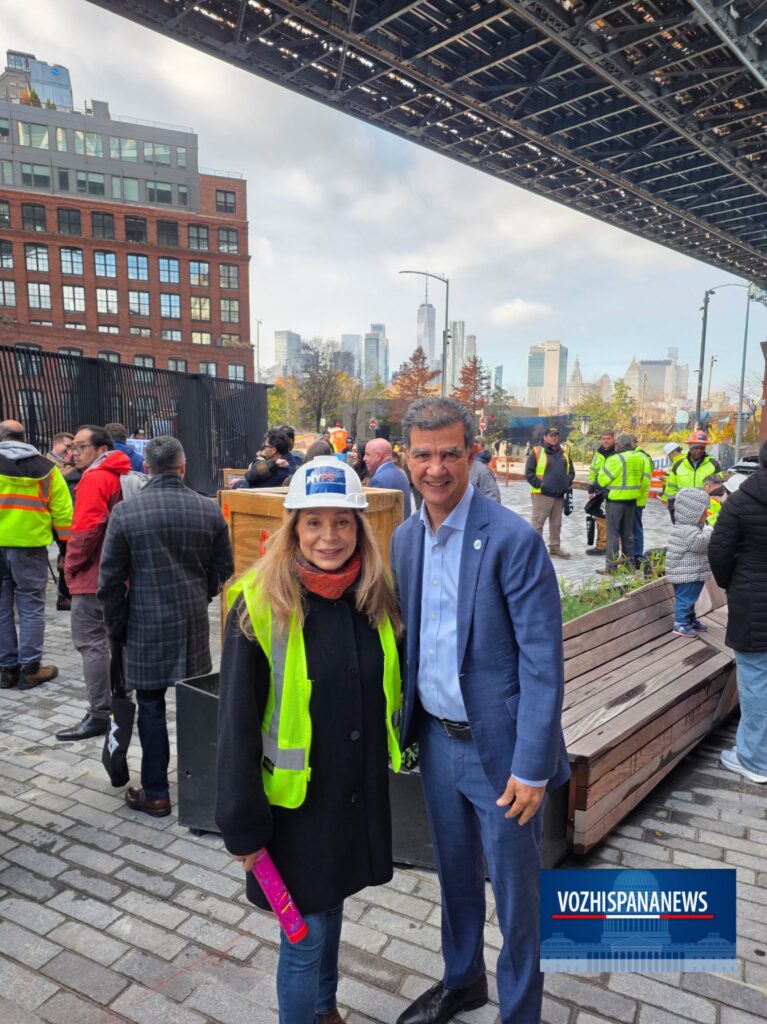

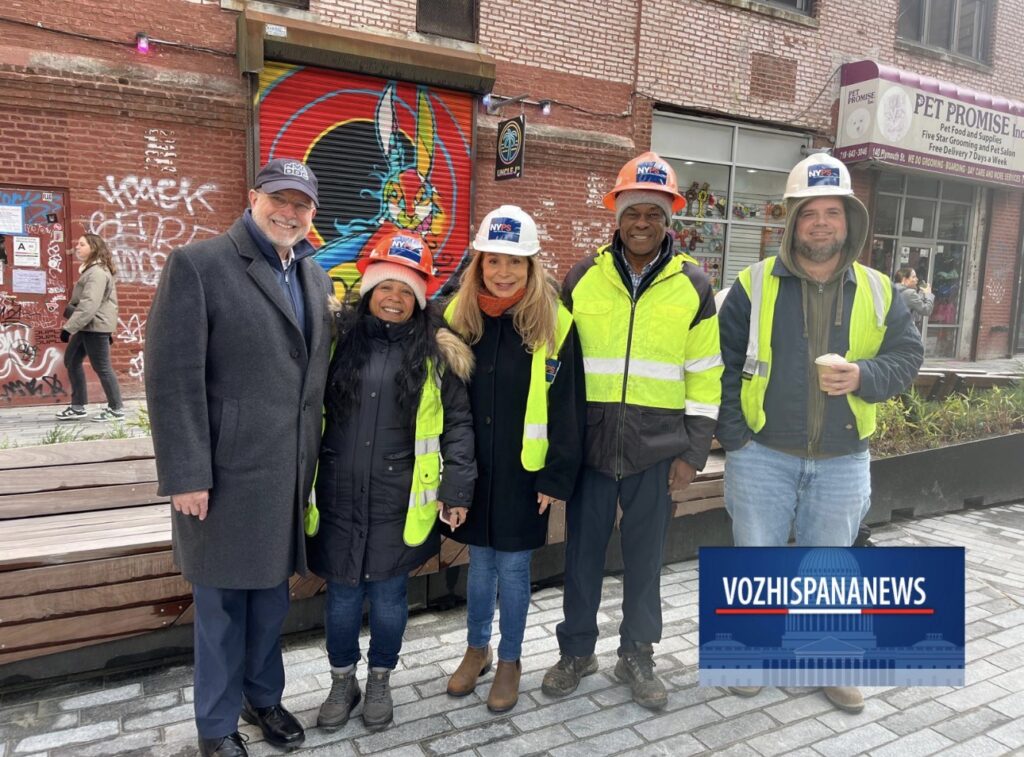
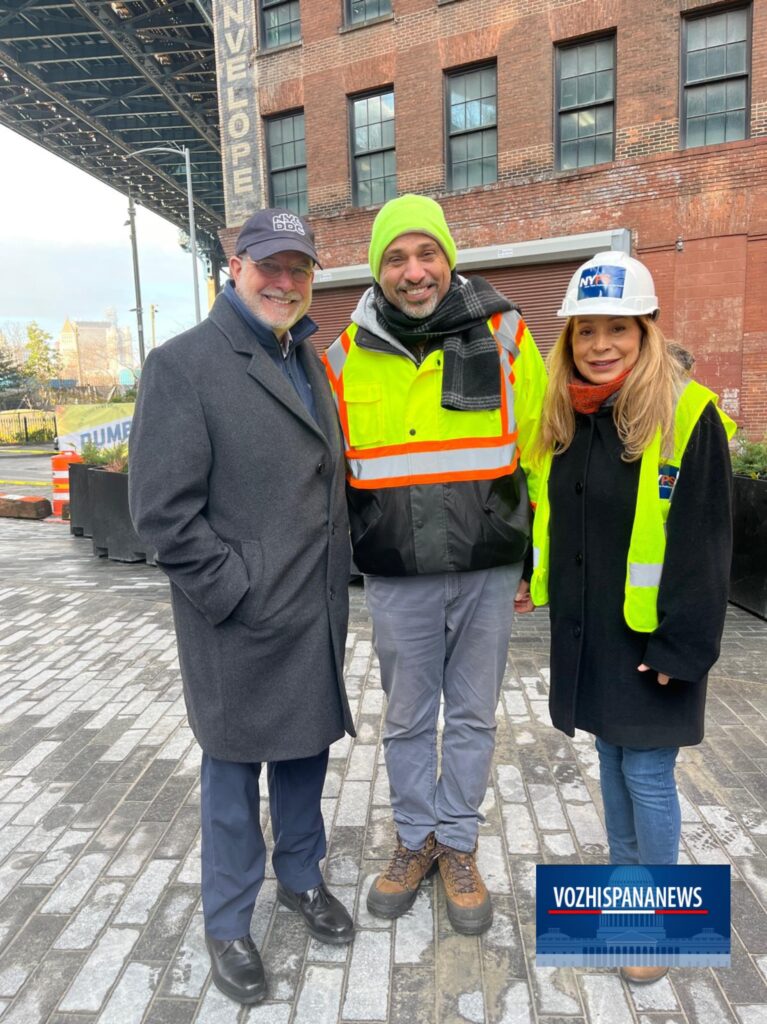
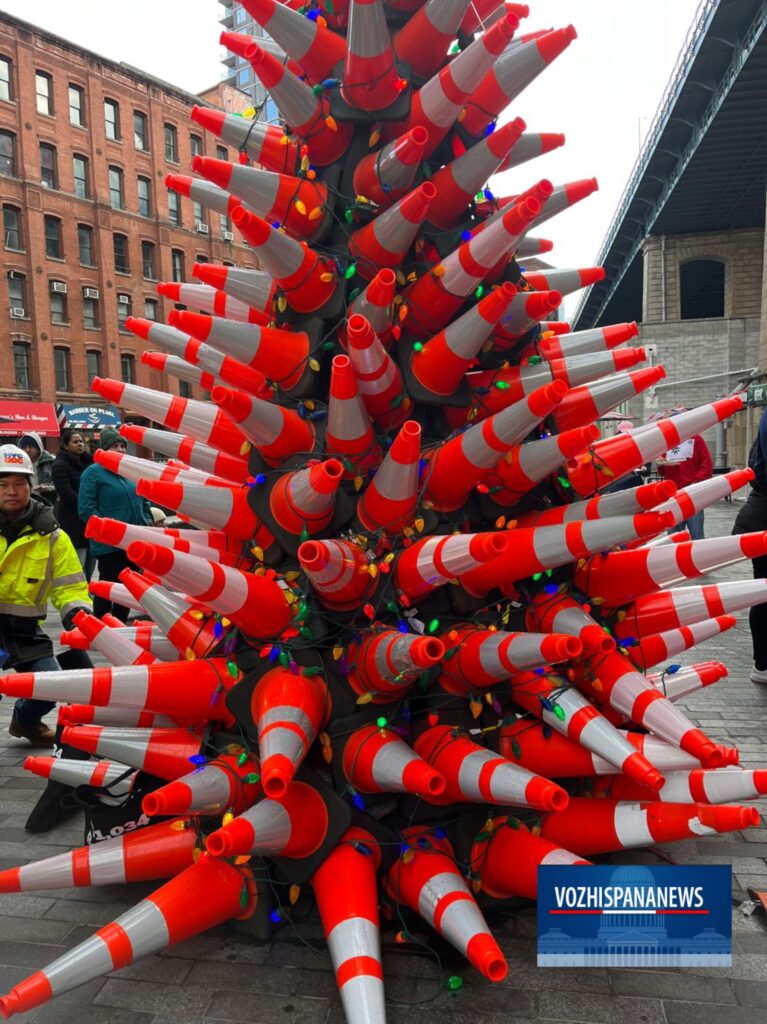
El Departamento de Transporte de Nueva York (NYC DOT), el Departamento de Protección Ambiental de Nueva York (DEP) y el Departamento de Diseño y Construcción de Nueva York (DDC) se unieron hoy a los funcionarios electos locales y al Distrito de Mejora de Negocios DUMBO para celebrar el final de un proyecto de infraestructura de 108 millones de dólares que completó una restauración histórica de 26 cuadras en el vecindario DUMBO de Brooklyn, reconstruyó calles empedradas, mejoró el drenaje de aguas pluviales, redujo la carga combinada de alcantarillado en el puerto, agregó nuevos carriles para bicicletas y creó el nuevo Pearl Street Plaza. DDC dirigió el proyecto, que comenzó en 2019 y fue financiado en gran medida por el DOT y el DEP de Nueva York, con fondos adicionales de los servicios públicos privados y el gobierno federal.
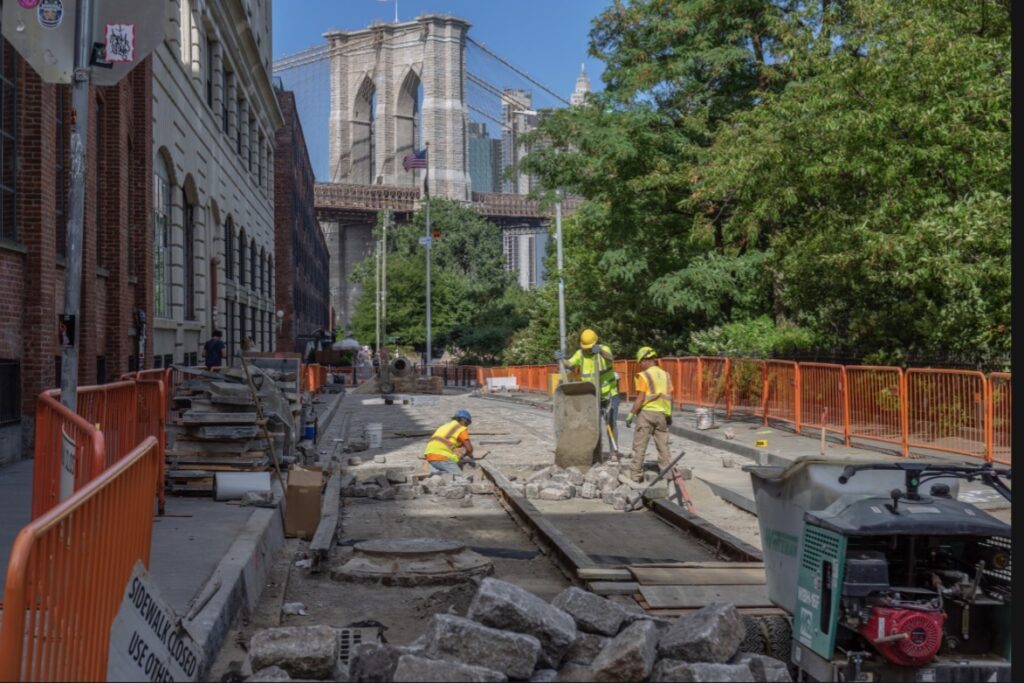
“Este proyecto especial ayudó a preservar la sensación histórica de DUMBO, estableció una plaza permanente de clase mundial en Pearl Street y creó una nueva red de bicicletas de barrio de caminos lisos de granito construidos en las calles empedradas”, dijo el comisionado del Departamento de Energía de Nueva York, Ydanis Rodríguez. “Agradecemos al DDC y al DEP por su trabajo y apreciamos la paciencia de los residentes durante la construcción”.
“Este proyecto es un gran ejemplo de cómo podemos modernizar la infraestructura crítica mientras preservamos el carácter histórico que hace que vecindarios como DUMBO sean tan especiales”, dijo el comisionado del DEP Rohit T. Aggarwala. “Al restaurar las calles empedradas y, al mismo tiempo, mejorar los sistemas de alcantarillado y aguas pluviales debajo de ellas, estamos mejorando la calidad del agua del puerto y mejorando la calidad de vida de esta vibrante comunidad costera”.

“Este fue un proyecto muy complicado en uno de los barrios más antiguos e históricos de la ciudad, con infraestructura muy antigua y calles estrechas empedradas, y logró múltiples objetivos tanto para los residentes como para los visitantes”, dijo el comisionado interino del DDC, Eduardo del Valle. “Debajo de las calles hay nuevas alcantarillas pluviales y tuberías de agua, mientras que las propias calles están restauradas con adoquines completos, bordillos y adoquines de granito y una nueva gran plaza. Agradecemos la colaboración con la comunidad, los servicios públicos privados y nuestros socios de la agencia; sin cooperación, este proyecto no habría tenido tanto éxito. Felicitaciones al equipo de DDC que completó este proyecto y gracias a los residentes por su paciencia mientras se realizaba el trabajo”.
“Trabajando en estrecha colaboración con nuestros socios en DDC, DOT y DEP, LPC aprobó una cuidadosa restauración del histórico bloque belga, junto con la instalación de nuevos materiales diseñados para armonizar con el icónico paisaje urbano en los distritos históricos de DUMBO y Vinegar Hill”, dijo Angie Master, la vicepresidenta de la Comisión de Preservación de Monumentos. “Este trabajo mejora la seguridad y la accesibilidad de estos vecindarios al tiempo que preserva su carácter histórico”.
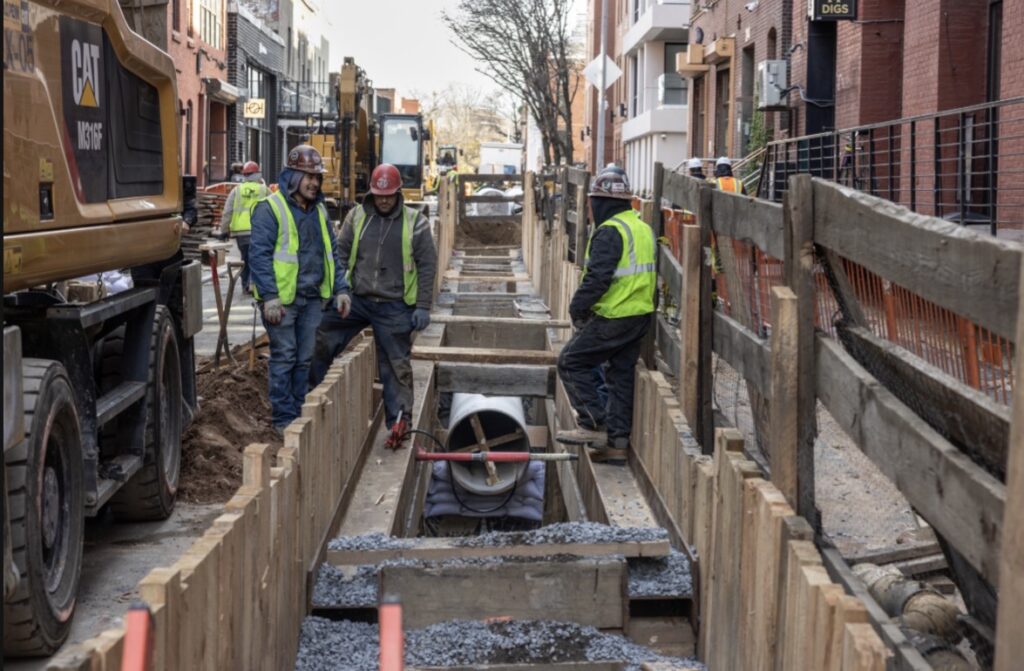
Detalles del proyecto
Se trabajaron veintiséis bloques de DUMBO, todos restaurados con adoquines completos y bordillos de granito históricamente precisos. Una cuadra, Gold Street entre Front Street y Water Street, era originalmente asfalto, pero se convirtió en adoquines durante el proyecto. Los otros 25 bloques originalmente habían sido todos adoquines, pero a lo largo de las décadas muchas de esas piedras habían sido perturbadas, se habían movido a un lado por varias razones y, en algunos casos, se habían quitado. En numerosas áreas, los adoquines habían sido pavimentados con asfalto.
El equipo de preservación histórica de DDC celebró numerosas sesiones de divulgación con la comunidad local mientras se diseñaba el proyecto, y los miembros de la comunidad expresaron firmemente que preferirían que los viejos adoquines permanecieran en sus ubicaciones originales. Como resultado, los adoquines que fueron retirados durante el trabajo se llevaron fuera del sitio para su almacenamiento y luego devueltos al bloque original donde se encontraron.
En general, el proyecto instaló más de 12.000 pies de nuevos bordillos de granito, 117.000 pies cuadrados de nuevas aceras de hormigón pigmentado, además de 114 nuevas rampas peatonales compatibles con la ADA. Además, se instalaron 8.800 pies de nuevos carriles para bicicletas de granito.
El proyecto también creó la nueva Pearl Street Plaza adyacente al Puente de Manhattan. La plaza tiene 2.500 yardas cuadradas e incluye un nuevo sistema de iluminación y vallas, además de numerosas macetas, sombrillas y áreas para sentarse. El arco debajo del puente que conecta con la plaza también ha sido restaurado con nueva iluminación. La superficie de la nueva plaza son adoquines de granito, y muchos de los adoquines de esta ubicación fueron reutilizados por el equipo del proyecto a otros bloques cuando fue necesario.
Debajo de las calles, para mejorar el drenaje de aguas pluviales, el proyecto instaló 2.735 pies de nuevas alcantarillas pluviales en áreas que anteriormente no tenían ninguna, con el segmento más grande que mide 5 pies de ancho por 2 pies de alto. Se actualizaron las 32 cuencas de captura existentes y se agregaron otras 46 nuevas para dirigir las aguas pluviales hacia el nuevo sistema.
Para reducir aún más la entrada de aguas residuales al puerto por desbordamientos combinados de alcantarillado, se convirtieron 2.121 pies de alcantarillas combinadas antiguas en alcantarillas sanitarias dedicadas. El proyecto también reemplazó más de 1.300 pies de alcantarillas sanitarias existentes, mejoró 6.600 pies de tuberías de agua y agregó 3.140 pies de nuevas tuberías de agua para fortalecer la confiabilidad del servicio.
El proyecto también construyó una nueva salida de aguas pluviales y eliminó una salida de alcantarillado combinada obsoleta y su cámara reguladora, que anteriormente desviaba las aguas residuales mixtas y las aguas pluviales durante las fuertes lluvias. Reemplazar esta infraestructura reducirá los respaldos de alcantarillado y mejorará la calidad del agua del puerto.
También se agregaron nueve nuevas bocas de incendios al vecindario, al igual, al alí como dos árboles adicionales.

Artefactos
La ciudad trabajó en estrecha colaboración con los conservacionistas históricos durante la planificación y la construcción del proyecto y se encontraron aproximadamente 2.800 artefactos durante la construcción, algunos tan antiguos como finales del siglo XVII, pero la mayoría que datan de mediados del siglo XIX hasta mediados del siglo XX. La mayor parte de la colección comprende varios tipos de cerámica doméstica, utilitaria y arquitectónica, incluidos objetos hechos de loce, gres y porcelana. Artefactos hechos de vidrio, metal, madera, piedra y cuero, junto con restos de fauna como huesos de animales, dientes y conchas, forman el resto. Dos de los artefactos más significativos encontrados fueron un botón de cobre de las décadas de 1860-1900 con el símbolo Excelsior del Estado de Nueva York y una pipa de arcilla para fumar de la década de 1820 y 1860 estampada con un motivo de Liberty Eagle. La ciudad está trabajando para encontrar una casa para mostrar los artículos al público.
#####################################
The NYC Department of Transportation (NYC DOT), the NYC Department of Environmental Protection (DEP) and the NYC Department of Design and Construction (DDC) today joined local elected officials and the DUMBO Business Improvement District to celebrate the end of a $108 million infrastructure project that completed a historic restoration of 26 blocks in Brooklyn’s DUMBO neighborhood, rebuilt cobblestone streets, improved stormwater drainage, reduced combined sewer loading into the harbor, added new bike lanes, and created the new Pearl Street Plaza. DDC led on the project, which began in 2019 and was largely funded by NYC DOT and DEP, with additional funding coming from private utilities and the federal government.
“This special project helped preserve the historic feel of DUMBO, establish a world-class permanent plaza on Pearl Street, and create a new neighborhood bike network of smooth, granite paths built into the cobblestone streets,” said NYC DOT Commissioner Ydanis Rodriguez. “We thank the DDC and DEP for their work and appreciate the patience of residents during the construction.”
“This project is a great example of how we can modernize critical infrastructure while preserving the historic character that makes neighborhoods like DUMBO so special,” said DEP Commissioner Rohit T. Aggarwala. “By restoring the cobblestone streets while simultaneously upgrading the sewer and stormwater systems beneath them, we’re improving harbor water quality and enhancing quality of life for this vibrant waterfront community.”
“This was a very complicated project in one of the city’s oldest and most historic neighborhoods, with very old infrastructure and narrow cobblestoned streets, and it accomplished multiple goals for residents and visitors alike,” said DDC Acting Commissioner Eduardo del Valle. “Below the streets there are new storm sewers and water mains, while the streets themselves are restored with full cobblestones, granite curbs and pavers and a new large plaza area. We appreciate the collaboration with the community, the private utilities and our agency partners – without cooperation, this project would not have been so successful. Congratulations to the DDC team that completed this project and thank you to the residents for their patience while work took place.”
“Working closely with our partners at DDC, DOT, and DEP, LPC approved careful restoration of historic Belgian block, paired with the installation of new materials designed to harmonize with the iconic streetscape in the DUMBO and Vinegar Hill Historic Districts,” said Landmarks Preservation Commission Vice Chair Angie Master. “This work improves the safety and accessibility of these neighborhoods while preserving their historic character.”
Project Details
Twenty-six blocks of DUMBO were worked on, all being restored with full cobblestones and historically accurate granite curbs. One block, Gold Street between Front Street and Water Street, was originally asphalt but was converted to cobblestones during the project. The other 25 blocks had originally been all cobblestones, but over the decades many of those stones had been disturbed, moved aside for various reasons and in some cases taken away. In numerous areas cobblestones had been paved over with asphalt.
DDC’s historic preservation team held numerous outreach sessions with the local community while the project was being designed, and community members expressed strongly that they would prefer for old cobblestones to remain in their original locations. As a result, cobblestones that were removed during work were taken off-site for storage and then returned to the original block where they were found.
Overall, the project installed more than 12,000 feet of new granite curbs, 117,000 square feet of new pigmented concrete sidewalks, plus 114 new ADA-compliant pedestrian ramps. Additionally, 8,800 feet of new granite bike lanes were installed.
The project also created the new Pearl Street Plazaadjacent to the Manhattan Bridge. The plaza is 2,500 square yards and includes a new lighting system and fencing, plus numerous planters, umbrellas and seating areas. The archway under the bridge that connects to the plaza has also been restored with new lighting. The surface of the new plaza is granite pavers, and many of the cobblestones from this location were repurposed by the project team to other blocks where needed.
Beneath the streets, to improve stormwater drainage, the project installed 2,735 feet of new storm sewers in areas that previously had none, with the largest segment measuring 5-foot-wide by 2-foot-high. All 32 existing catch basins were upgraded and another 46 new ones were added to direct stormwater into the new system.
To further reduce sewage from entering the harbor from combined sewer overflows, 2,121 feet of old combined sewers were converted into dedicated sanitary sewers. The project also replaced more than 1,300 feet of existing sanitary sewers, upgraded 6,600 feet of water mains, and added 3,140 feet of new water mains to strengthen service reliability.
The project also built a new stormwater outfall and removed an outdated combined-sewer outfall and its regulator chamber, which previously diverted mixed sewage and stormwater during heavy rain. Replacing this infrastructure will reduce sewer backups and improve harbor water quality.
Nine new fire hydrants were also added to the neighborhood, as were two additional trees.
Artifacts
The city worked closely with historic preservationists during the planning and the construction of the project and approximately 2,800 artifacts were found during construction, some as old as the late-1600s but most dating from the mid-1800s to the mid-1900s. The majority of the collection comprises various types of domestic, utilitarian, and architectural ceramics, including objects made of earthenware, stoneware, and porcelain. Artifacts made of glass, metal, wood, stone, and leather, along with faunal remains like animal bones, teeth, and shell make up the remainder. Two of the most significant artifacts found were a copper button from the 1860s-1900s with the New York State Excelsior symbol and a clay smoking pipe from the 1820s-1860s stamped with a Liberty Eagle motif. The city is working to find a home to display the items for the public.
About the NYC Department of Environmental Protection
DEP manages New York City’s water supply, providing approximately 1 billion gallons of high-quality drinking water each day to nearly 10 million residents, including 8.5 million in New York City. The water is delivered from a watershed that extends more than 125 miles from the city, comprising 19 reservoirs and three controlled lakes. Approximately 7,000 miles of water mains, tunnels and aqueducts bring water to homes and businesses throughout the five boroughs, and 7,500 miles of sewer lines and 96 pump stations take wastewater to 14 in-city treatment plants. DEP also protects the health and safety of New Yorkers by enforcing the Air and Noise Codes and asbestos rules. For more information, visit nyc.gov/dep, like us on Facebook, or follow us on X, formerly known as Twitter.
About the NYC Department of Transportation
The New York City Department of Transportation’s (NYC DOT) mission is to provide for the safe, efficient, and environmentally responsible movement of people and goods in the City of New York and to maintain and enhance the transportation infrastructure crucial to the economic vitality and quality of life of our primary customers, City residents. NYC DOT’s staff manage an annual operating budget of $1.4 billion and a ten-year $33 billion capital program, along with 6,300 miles of streets and highways, over 12,000 miles of sidewalk, and approximately 800 bridges and tunnels, including the iconic East River bridges. NYC DOT’s staff also installs and maintains nearly one million street signs, 13,250 signalized intersections, over 315,000 street lights, and over 350 million linear feet of markings.
About the NYC Department of Design and Construction
The Department of Design and Construction is the City’s primary capital construction project manager. In supporting Mayor Adams’ long-term vision of growth, sustainability, resiliency, equity and healthy living, DDC provides communities with new or renovated public buildings such as firehouses, libraries, police precincts, and new or upgraded roads, sewers and water mains in all five boroughs. To manage this $33 billion portfolio, DDC partners with other City agencies, architects and consultants, whose experience bring efficient, innovative and environmentally-conscious design and construction strategies to City projects. For more information, please visit nyc.gov/ddc.

